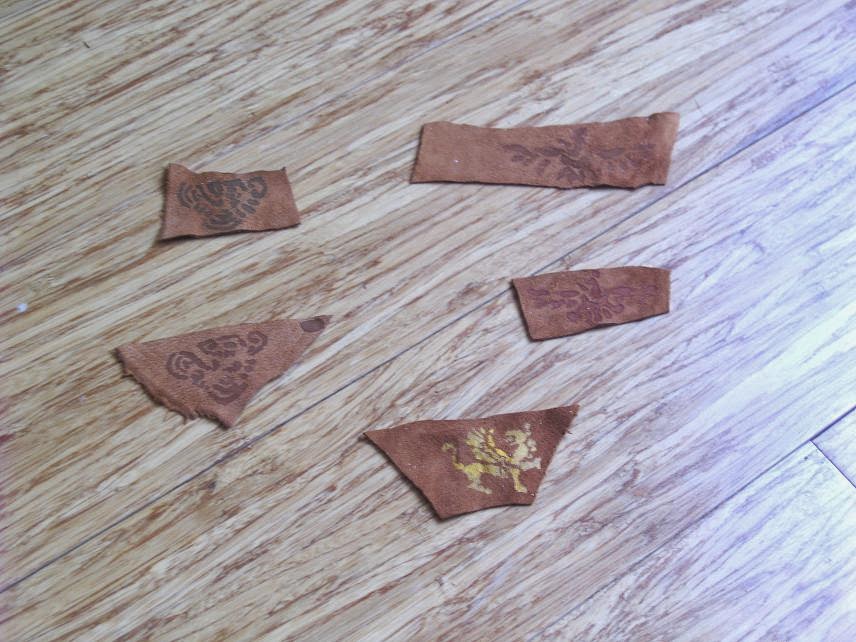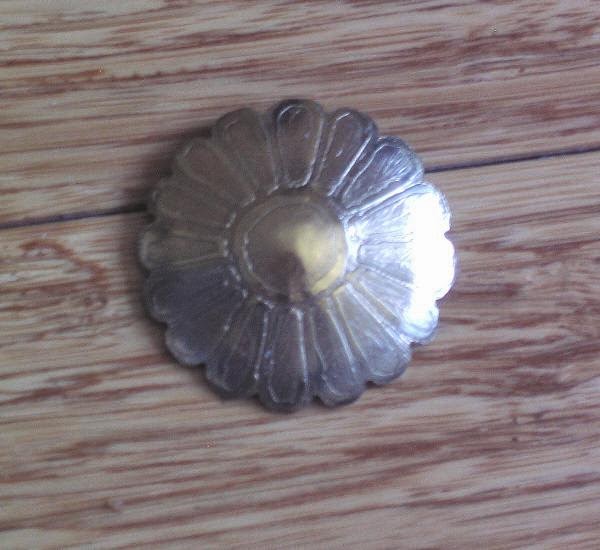A guide to the Achaemenid Persian empire for reenactors, focusing on the Graeco-Persian Wars period. A quick guide to Persian history, society, religion, military, clothing and culture, plus links to reenactment groups and commemorations of the 2,500th anniversary of the Graeco-Persian Wars.
Saturday, June 28, 2014
Friday, June 27, 2014
New theory on Cambyses' lost army
(thanks Alan Rowell via Facebook) Olaf Kaper of Leiden University presents a theory on the fate of Cambyses II's army that disappeared during the Persian conquest of Egypt in 524 BC.
Sunday, June 8, 2014
Hide glue paint - the rain test!
Clockwise from bottom: acrylic, hide glue with natural pigment, hide glue with natural pigment and food color, hide glue with pigment and alum, and hide glue with pigment, food color and alum.
After an hour's soak and a little rubbing.
Wow! All the hide glue patterns washed out to the point of being barely noticeable, regardless of alum content. Either I'm missing some information, or this is just to be expected - if historical paintwork was done in this way at all.
Saturday, June 7, 2014
Last notes on this, I swear
The flower concho's petals and central circle in the OIP line art had a slightly rimmed appearance. Assuming this to be accurate, I attempted to duplicate it by masking just the edges of these features on my newly-etched concho and giving it a short dunk of about 15 minutes in the chloride.
I'd hoped that this would make the features stand out more. It didn't, but it does look a bit closer to the OIP drawing. But the edges should be defined by gentle swellings, not sharp-edged borders. I don't know how to correct this.
Interestingly, both the first and second etchings made a striated effect, always pointing toward the center, on all the exposed metal. Internal crystalline structure after forging? Something to do with the flow of etchant across the surface?
Lastly, I used some fine files to scallop the edges. At this point, any further cleanup will be unnoticeable to anyone but myself, so the project is for all intents and purposes finished.
Tomorrow, final results on hide glue paint!
I'd hoped that this would make the features stand out more. It didn't, but it does look a bit closer to the OIP drawing. But the edges should be defined by gentle swellings, not sharp-edged borders. I don't know how to correct this.
Interestingly, both the first and second etchings made a striated effect, always pointing toward the center, on all the exposed metal. Internal crystalline structure after forging? Something to do with the flow of etchant across the surface?
Lastly, I used some fine files to scallop the edges. At this point, any further cleanup will be unnoticeable to anyone but myself, so the project is for all intents and purposes finished.
Tomorrow, final results on hide glue paint!
Monday, June 2, 2014
Improvements for the Northern-style concho
As I've discussed before, the early Achaemenid weapon belt included a shallow bronze concho which often had a flower design cast on. In the absence of castings that could accurately replicate the originals, an acceptable substitute is a Northern-style concho. However, it still has some differences, the most notable of which is that it has a small round loop on the back instead of a riveted bar.
You could, of course, leave your concho the way you receive it. The alterations here are worthwhile if you happen to be set up for silver soldering (as of this writing, a low-end gas torch, tub of flux and coil of solder come to 20USD, give or take a few).
First the solder on the back is melted and the copper loop removed. Unfortunately, it's too short to do anything with, so I tossed that one and used one of those huge copper-plated staples from a cardboard box, simply bent to shape with pliers and trimmed with wire cutters.
The advantages of this design, aside from a more accurate shape, are that it holds the concho closer to the belt, and that it can be used with either a thick, narrow leather lace or a flat, wide thong.
Before installing the back bar, I decided to beat the concho into a more conical shape with a small ball-peen hammer. Unfortunately, my forging skills are mediocre and left it slightly lumpy, so I covered that up by going ahead and adding the classic flower design seen on some historical examples.
These designs were originally cast on, but a similar appearance can be affected by engraving or etching. Since I don't know how to engrave, I etched it using some ferric chloride with permanent marker as a resist. The chloride took about half an hour to make a good 3D design.
In order to let the flower stand out, I didn't burnish it as thoroughly as I could have. Some of the permanent marker, dissolved with nail polish remover and scrubbed with a nylon sponge, tends to stick in the rough etched surface and provide a good contrast with the un-etched surface where the resist had been..
Image from OIP 69, which you should go download right now.
You could, of course, leave your concho the way you receive it. The alterations here are worthwhile if you happen to be set up for silver soldering (as of this writing, a low-end gas torch, tub of flux and coil of solder come to 20USD, give or take a few).
First the solder on the back is melted and the copper loop removed. Unfortunately, it's too short to do anything with, so I tossed that one and used one of those huge copper-plated staples from a cardboard box, simply bent to shape with pliers and trimmed with wire cutters.
The advantages of this design, aside from a more accurate shape, are that it holds the concho closer to the belt, and that it can be used with either a thick, narrow leather lace or a flat, wide thong.
Before installing the back bar, I decided to beat the concho into a more conical shape with a small ball-peen hammer. Unfortunately, my forging skills are mediocre and left it slightly lumpy, so I covered that up by going ahead and adding the classic flower design seen on some historical examples.
These designs were originally cast on, but a similar appearance can be affected by engraving or etching. Since I don't know how to engrave, I etched it using some ferric chloride with permanent marker as a resist. The chloride took about half an hour to make a good 3D design.
In order to let the flower stand out, I didn't burnish it as thoroughly as I could have. Some of the permanent marker, dissolved with nail polish remover and scrubbed with a nylon sponge, tends to stick in the rough etched surface and provide a good contrast with the un-etched surface where the resist had been..
Subscribe to:
Posts (Atom)




